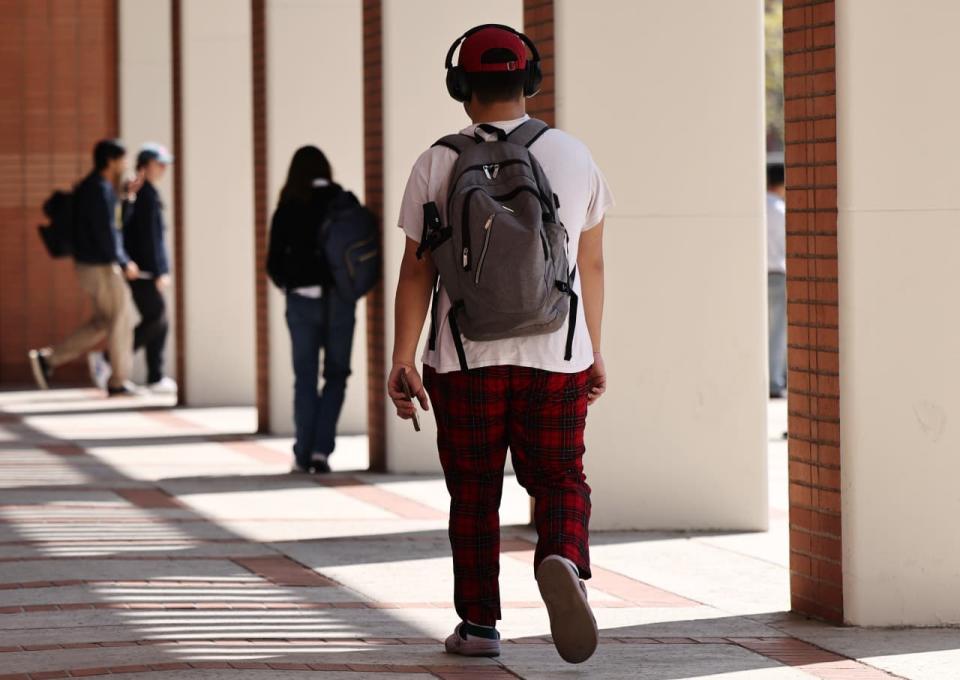

When Christina Paliogiannis officially learned in March 2023 that her student debt would be canceled, she hung the letter on the fridge.
Most Read from MarketWatch
“It was just a huge burden lifted off of me,” the 42-year-old said.
Since she graduated from law school in 2012, Paliogiannis has had to make sacrifices in order to fit her student-loan payments into her budget on her salary as a public defender. For years, she spent four and a half hours a day commuting to and from her office on Staten Island, because she had a place she could live rent-free on Long Island.
She’s also spent countless hours going back and forth between her various student-loan servicers and her employer to make sure she was on track for relief through the Public Service Loan Forgiveness program. That initiative allows borrowers who work for the government or for certain nonprofits to have their debt canceled after 10 years of payments. Initially, her servicer was projecting that her debt would not be canceled until 2025, even though she has worked as a public defender and paid on her loans since she graduated.
But thanks to fixes to PSLF made by the Biden administration that allowed time Paliogiannis spent in processing delays to be counted toward forgiveness, she had her debt canceled last year. Without the student-loan payments, she’s been able to focus on paying down credit-card debt. She also felt comfortable taking an apartment in New York City.
“Now my commute is significantly better,” she said. “I’ve been able to save myself quite a few hours during the week, which is a lovely thing.”
In many ways, Paliogiannis is typical of the more than four million borrowers who have had their debt canceled through the Biden administration’s efforts, according to research published Monday by the Jain Family Institute, a nonprofit research organization. The analysis is the first to provide a sense of who has benefited from the $153 billion in debt cancellation over the past few years and how that relief has affected them. And it comes as the Biden administration is pitching a debt-relief plan that, if implemented, could impact more than 25 million borrowers.
The data doesn’t capture the full universe of borrowers who have had their loans wiped out, because the oldest borrowers in the data set are 49. But of the borrowers the researchers studied, those who benefited from debt relief tend to be slightly older, they’re more likely to have graduated during or shortly after the 2007-09 recession, and their incomes are lower than those of borrowers who repaid their loans.
The debt relief allowed these borrowers to pursue other financial priorities, like buying a home or taking on a loan to buy a car, the researchers found.
“It’s fair to say that student debt is holding back student borrowers from making investments in homes and other secured loans,” said Marshall Steinbaum, a senior fellow in higher education at the Jain Family Institute and one of the authors of analysis. “If we canceled more student debt, we would get more student borrowers able to make those kinds of investments.”
Little data on the impact of student-debt cancellation
Over the past several years, policy makers and pundits have debated about who benefits the most from student-debt cancellation and what kind of impact it might have on borrowers. The debate has mostly been based on economic models.
In 2019, a group of finance researchers found that for 10,000 borrowers who had their private loans canceled through court rulings, the debt relief boosted their income and allowed them to move, change jobs or return to school. But other than that relatively small-scale natural experiment, there’s little data on the impact of debt cancellation. The research released Monday is the first to provide insight into the wide swath of borrowers who have had their federal student debt canceled.
Under the Biden administration, officials have taken action to wipe out student loans for borrowers who attended poor-performing schools and have streamlined the process for debt relief for borrowers pursuing PSLF, as well as borrowers who have been in repayment on their loans for more than 20 years. Recently, the Biden administration also began canceling debt through a provision of its new repayment program that covers borrowers who took on relatively small loans initially and have been paying on their debt for at least 10 years.
Steinbaum and his co-authors were able to dig into the effects of some of these efforts by analyzing credit-panel data that they have been researching for years. The data encompasses borrowers who were between the ages of 18 and 34 starting in 2009 and tracks them through 2023.
The authors looked at borrowers whose loan balances went to zero between 2020 and 2023, comparing the outcomes of borrowers who had their debt canceled with the outcomes of borrowers who had similar precancellation student-loan payments. They also looked at the characteristics of borrowers who reached zero balances by various means, including cancellation, bankruptcy discharge and repaying the debt.
(Some of the debt relief was geared toward borrowers who have been paying for at least 20 years, and some of those borrowers are not in the data set because they are older than 49. In addition, the data doesn’t cover borrowers who had their debt canceled in 2024.)
What the researchers found challenges some of the conventional wisdom — or at least political talking points — surrounding student-debt cancellation. Some researchers have said broad student-debt relief would disproportionately benefit well-off borrowers. The thinking was that borrowers with high balances would have more debt canceled, and that having a high student-loan balance tends to be associated with having a graduate or professional degree.
But that wasn’t the case, the researchers found.
“The idea that student borrowers who get their loans canceled are relatively privileged — that is not consistent with our findings,” said Steinbaum, who is also an economist at the University of Utah.
Instead, the borrowers who had their debt wiped out tended to be less well off than the borrowers who repaid their loans. Borrowers who had their debt canceled in 2020 and 2021 had a median income of $71,000, while borrowers who repaid their debt in those years had a median income of $128,000. Those who had their debt canceled in 2022 and 2023 had a median income of $108,000, while borrowers who repaid their debt in those years had a median income of $147,000.
The borrowers who benefited from debt relief were also more likely to have graduated from school during or shortly after the 2007-09 recession. That’s consistent with research by Steinbaum and Sergio Pinto, a doctoral student at the University of Maryland’s School of Public Policy, that indicates that borrowers’ debt ramped up during this period and that they struggled to repay it. That’s due to a combination of factors, including declining state funding, which pushed tuition up at some public colleges; a ramp-up in enrollment in for-profit colleges; and demands from employers that workers have higher degrees, but without a corresponding bump in pay.
Borrowers underwater on their loans
In addition, borrowers who ultimately had their debt canceled were more likely to see their balances grow in the lead-up to having their debt wiped out because they were enrolled in income-driven repayment programs. Through these plans, borrowers repay their debt as a percentage of their income. But often borrowers’ payments on these plans are so low that they don’t cover the interest on their loans. Until recently, that meant some borrowers saw their balances grow despite making payments.
“There are some borrowers who entered repayment during or after the Great Recession and have basically been underwater on their student loans ever since,” Steinbaum said.
That was the case for Paliogiannis. When she left law school, she had about $250,000 in student debt. She never fell behind on her loan payments — and yet, by the time her balance was canceled in 2023, it had ballooned to $307,000.
“Even though I was making payments, my loan kept going up and up and up, which was incredibly stressful,” she said.
The research indicates that although income-driven repayment plans like the one Paliogiannis was on can help borrowers manage their monthly bills, those plans don’t allow borrowers to take other major financial steps. The likelihood that a borrower will own a home increases by 5 percentage points in the first two years following debt cancellation, the research found. Borrowers’ car-loan balances increase by about $1,000, on average, two years after debt cancellation.
The data doesn’t indicate why student-debt cancellation increases asset ownership when income-driven repayment doesn’t seem to have that effect, Steinbaum said. It could be because, with a student loan on their balance sheet, a borrower’s debt-to-income ratio is too high to qualify for other types of loans, or that psychologically they don’t want to take on another debt burden while still owing on their student loans. In addition, even with income-driven repayment, borrowers’ monthly student-loan payment may still be too high to make a mortgage or car payment affordable.
For student-loan borrowers who owe more on their debt than they originally took out, “cancellation is really the only opportunity for them to have asset ownership,” said Laura Beamer, one of the co-authors of the paper and the lead researcher on higher-education finance at the Jain Family Institute. That, she said, “is really quite striking.”
The findings could provide some insight into the impact of the Biden administration’s latest proposal for mass student-debt cancellation, which could wipe out some or all of the debt for more than 25 million borrowers. To the researchers, the data indicates that canceling debt is a better mechanism for improving financial outcomes for student-loan borrowers than tweaking the student-loan system through efforts like modifying repayment plans.
“We look particularly at financial outcomes, because that’s the kind of data set we have,” Beamer said. “The possibilities for borrowers to get their debt canceled, especially considering that they’ve been in repayment sometimes 20, 25 years or even more, has impacts in all aspects of their life.”
Most Read from MarketWatch
EMEA Tribune is not involved in this news article, it is taken from our partners and or from the News Agencies. Copyright and Credit go to the News Agencies, email news@emeatribune.com Follow our WhatsApp verified Channel








